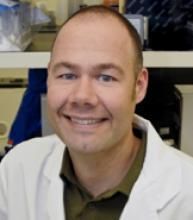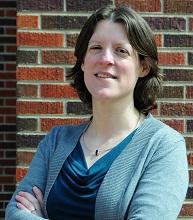
 A couple of local scientists at Rocky Mountain Laboratories, Dr. Emmie de Wit and Dr. Vincent Munster, along with National Institute of Allergy and Infectious Diseases (NIAID) colleagues in Bethesda, Maryland, Dr. Barney Graham and Dr. Kizzmekia Corbett, and Jason McLellan, a structural virologist at the University of Texas, were all recently honored with the prestigious 2020 Golden Goose Award for their work on coronaviruses and the role they played in developing a vaccine for SARS-CoV-2, the coronavirus that causes the COVID-19 disease.
A couple of local scientists at Rocky Mountain Laboratories, Dr. Emmie de Wit and Dr. Vincent Munster, along with National Institute of Allergy and Infectious Diseases (NIAID) colleagues in Bethesda, Maryland, Dr. Barney Graham and Dr. Kizzmekia Corbett, and Jason McLellan, a structural virologist at the University of Texas, were all recently honored with the prestigious 2020 Golden Goose Award for their work on coronaviruses and the role they played in developing a vaccine for SARS-CoV-2, the coronavirus that causes the COVID-19 disease.
The Golden Goose Award was established in 2012 to recognize how scientific research in certain areas of knowledge may at times be viewed as a waste of valuable time and resources until circumstances change and the accumulated information and knowledge suddenly applies in ways not foreseen.
According to Steve Holland, who directs intramural (in-house) research at NIAID, one of the main reasons that vaccine development and production against SARS-CoV-02 was able to move so quickly was due in large part to the work being done for years by a relatively small number of researchers working on coronaviruses, including these award winners.
Severe Acute Respiratory Syndrome (SARS), a highly deadly coronavirus, first appeared in China in 2002 and quickly spread worldwide within a few months, but it was also quickly contained. Then came the Middle East Respiratory Syndrome (MERS), first reported in Saudi Arabia in 2012. Graham and Corbett started working on coronaviruses at the tail end of the MERS outbreak. Partnering with McLellan and his team in Austin, Texas, the group defined the structure of the SARS-CoV-2 spike protein. Although none of them could have predicted just how important their ongoing basic research would become in addressing COVID-19, it gave them, in essence, a head start against the pandemic.
The team quickly went to work on a vaccine candidate that involves messenger RNA, or mRNA, a kind of genetic material that delivers a stabilized version of the spike protein based on the previous work with the MERS coronavirus. An existing partnership with a pharmaceutical company, Moderna, also helped speed the process. This vaccine is currently being used in Montana, although the roll out of the vaccination program has been plagued by delays.
Holland said that the team’s work was far out in front of anything that had been done before. “If you’d have waited until the pandemic existed, you’d have waited too long,” he said.
The RML scientists Munster and de Wit, who met in the Netherlands and married in 2009, already shared a strong interest in emerging diseases when they met.
De Wit, an aspiring microbiologist, was working toward her PhD at Erasmus University Rotterdam at the time when an emergence of bird flu occurred. She and her lab mates jumped into action to identify the virus and work on patient samples. The work became the basis for her thesis project on the replication, pathogenesis and transmission of influenza A virus. It was the beginning of a career spent investigating emerging viral outbreaks. She went on to study the MERS virus and the Ebola virus, among other things.
When the first cases of COVID-19 were reported last year, de Wit’s team at RML had just published a study that showed the experimental antiviral drug remdesivir was effective in treating rhesus macaques infected with the Middle East Respiratory Syndrome (MERS) coronavirus. By April they had demonstrated that the drug also worked on the virus causing COVID-19. Currently, Dr. de Wit’s research aims to combine pathogenesis studies with detailed molecular analyses to identify molecular determinants of severe respiratory tract disease within the virus and the host.
Munster, on his part, shared his wife’s interest in emerging diseases from the beginning. When they met he was investigating viral outbreaks trying to understand where viruses come from and how it is that they spill over from the natural world into humans. Among his projects, at the time, was a stint working in the Middle East on camels during the MERS epidemic.
He said research on other viral diseases had shown that they may be traced to a spillover from a particular species of animal. In some cases the disease impacts the carrier species but in other cases it may be transferred to a second species that shows no signs of infection and exhibits no symptoms, but nonetheless carries the disease. This was the case with Swine Flu, for instance.
It has become a matter of course based on these experiences to check all the domestic animals in the area of an outbreak. He said here it would mean checking horses, cows, pigs, sheep and chickens and the like. In the Middle East it meant checking on the camels. It turned out that camels were a very effective asymptomatic transmission vector for passing the MERS infection on to people.
Munster’s major areas of research include investigating the natural reservoirs of emerging viruses and elucidation of the underlying biotic and abiotic drivers of disease transmission events, as well as the evolutionary dynamics of emerging viruses in the context of virus-host ecology. He also works on modeling zoonotic and cross-species transmission of emerging viruses and the efficacy of outbreak intervention strategies.
Munster and de Wit came to RML along with internationally recognized virologist Dr. Heinz Feldmann in 2009. Munster now serves as Chief of the Virus Ecology Unit at the lab. De Wit is Principal Investigator in the Molecular Pathogenesis Unit. They have separate research labs at Rocky Mountain Labs but work in close collaboration.
“We have different skill sets, and when you put them together, they work really well,” said de Wit. They work with animals to learn about viruses and create tests to figure out whether vaccine candidates and treatments have the potential to work in humans.
With SARS-CoV-2, their skills in developing animal models for previous viruses came in handy, and like their colleagues in Bethesda, they were able to quickly get their COVID-19 response research up and running. When the pair first learned of the new virus, “we immediately dropped everything,” de Wit says. Since that moment in January, using routines devised from their earlier investigations, they have developed new ways to understand the virus and test multiple vaccine candidates and potential antiviral treatments.
Thanks to the work of Corbett, Graham, de Wit and Munster, as well as McLellan and many other researchers who have dedicated their careers to the study of infectious diseases, several vaccine candidates have already progressed to Phase 3 clinical trials, generally the final and most rigorous phase of testing, to see if they will work to prevent the novel coronavirus from taking hold in humans. On November 16, Moderna, the company partnering with the NIAID team, announced its initial findings that its vaccine was more than 94 percent effective at preventing COVID-19. It was the second after Pfizer to show such a hopeful finding.